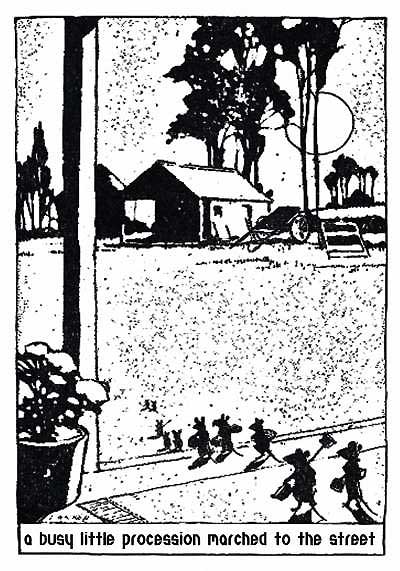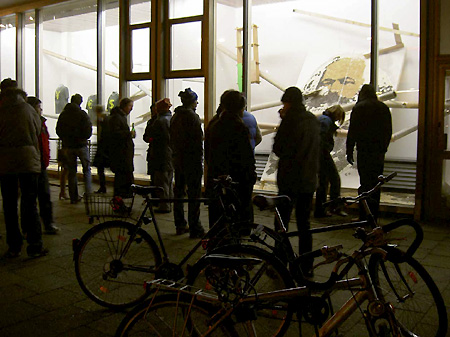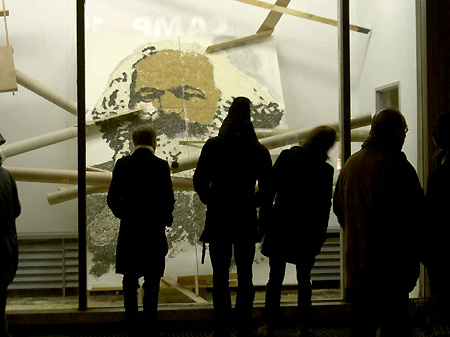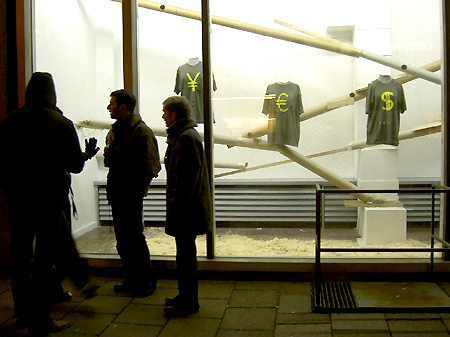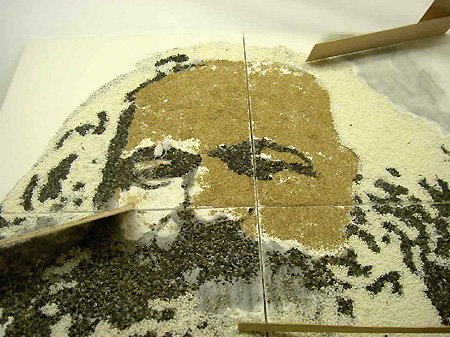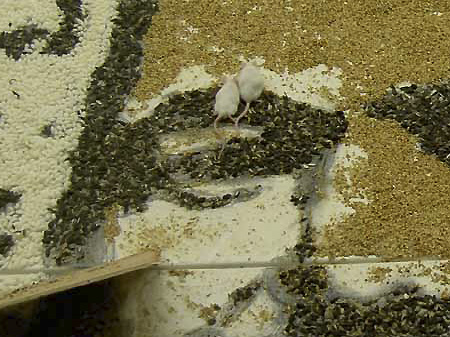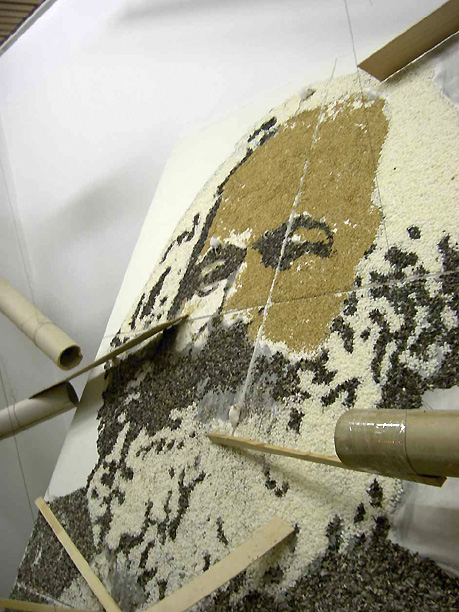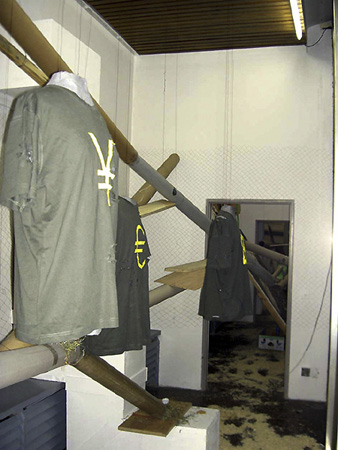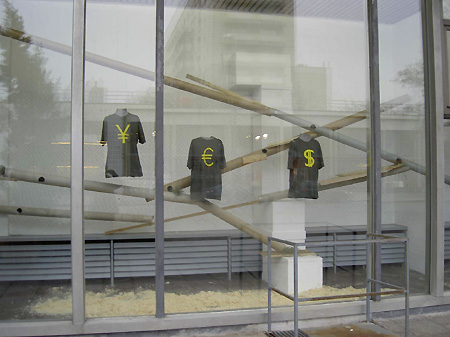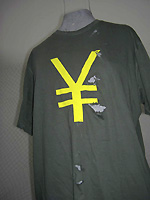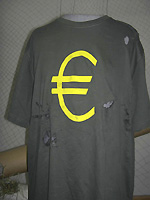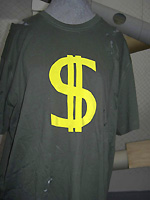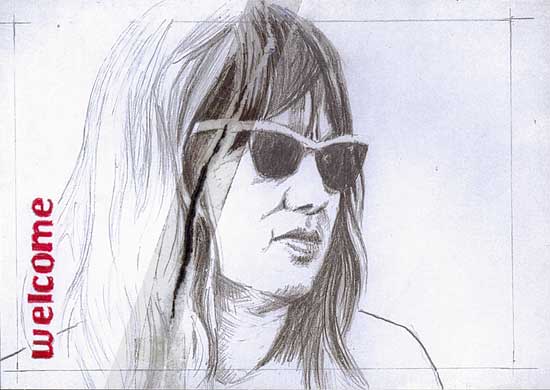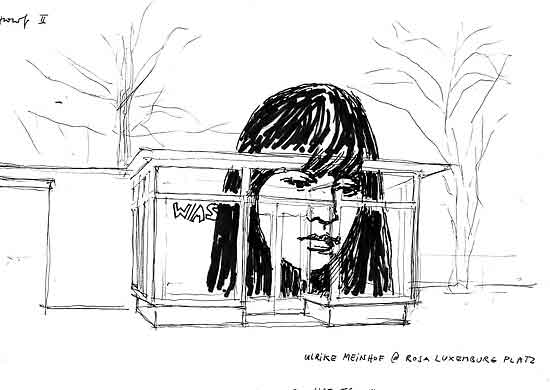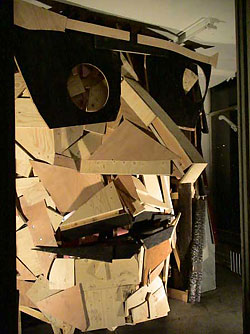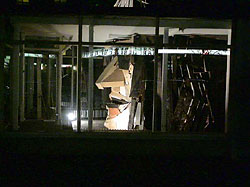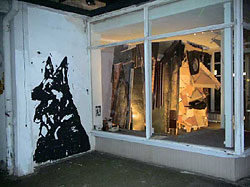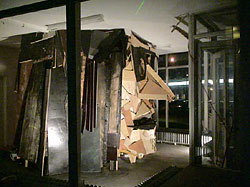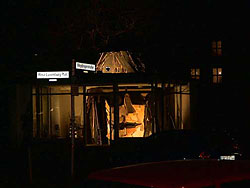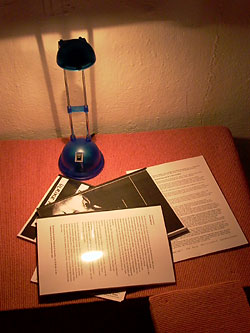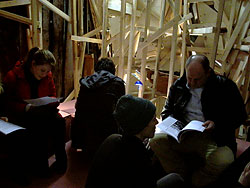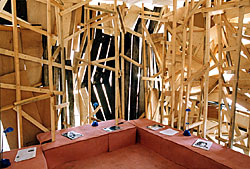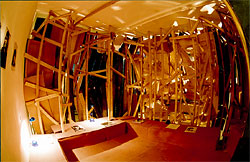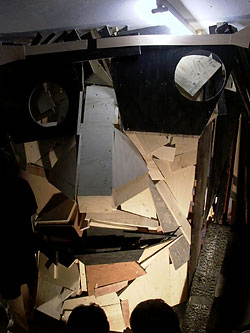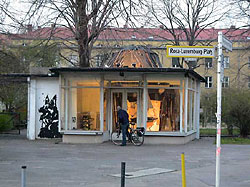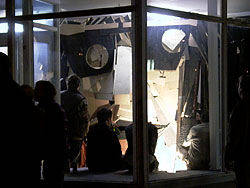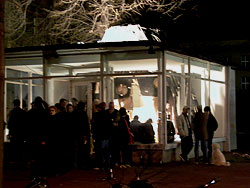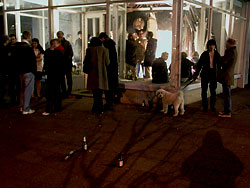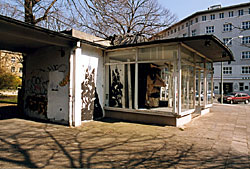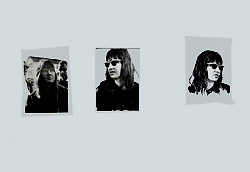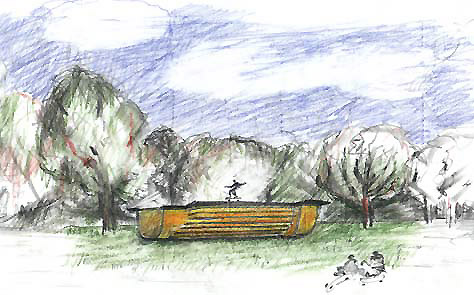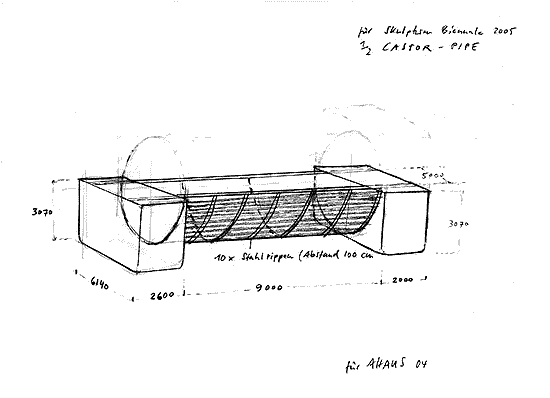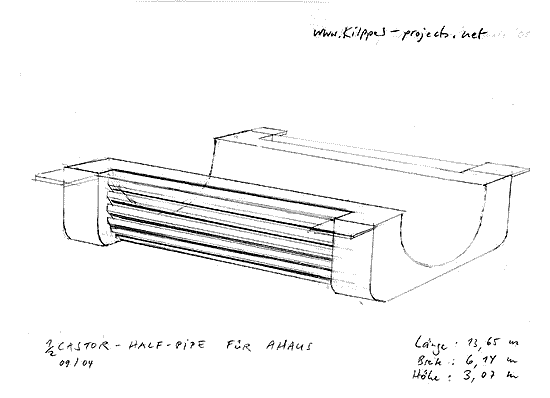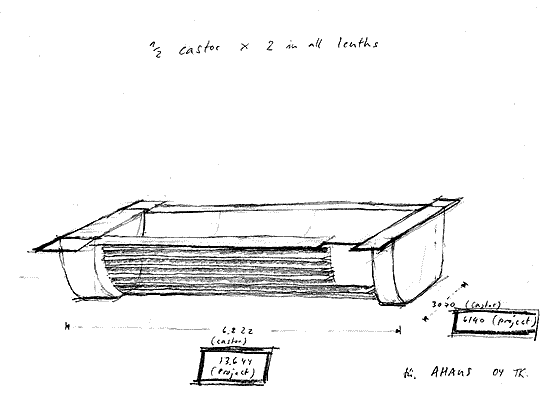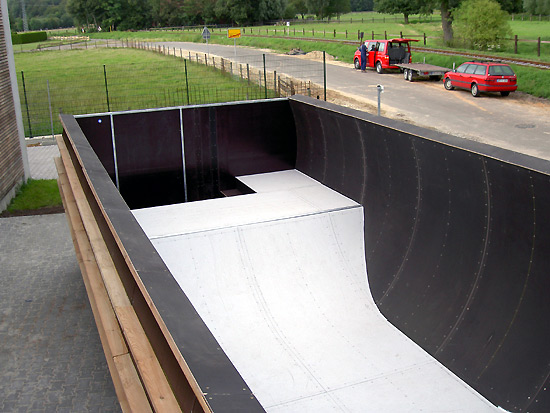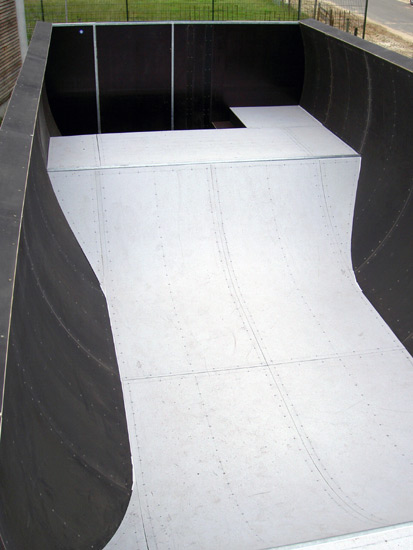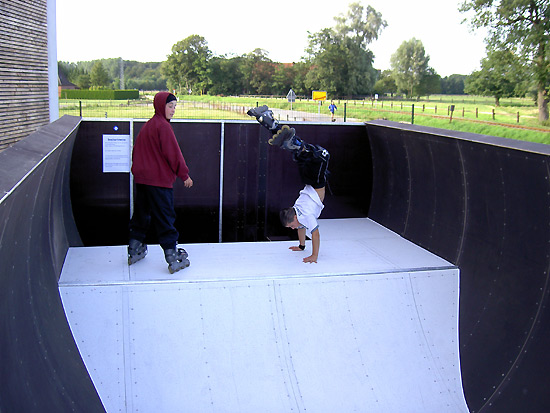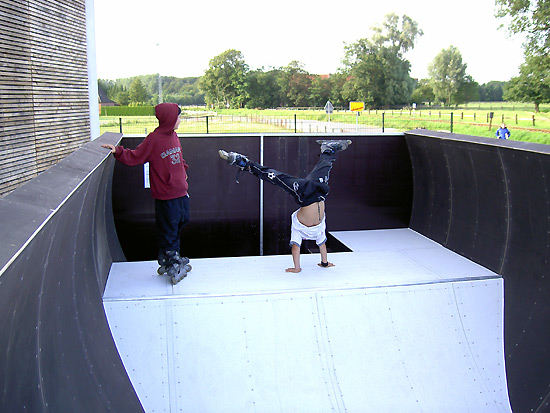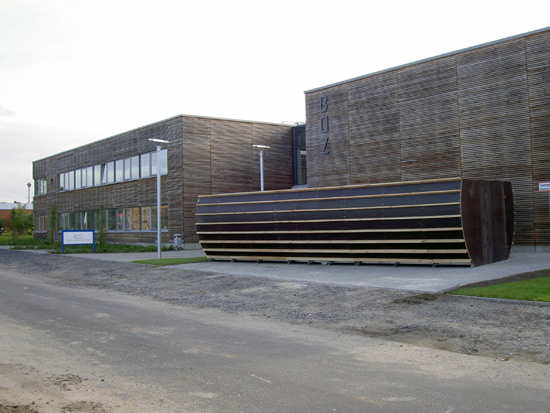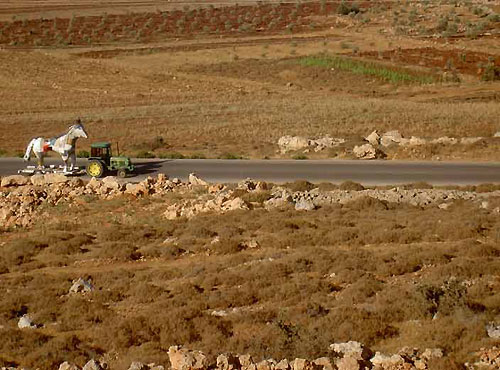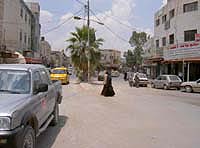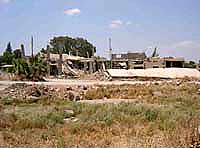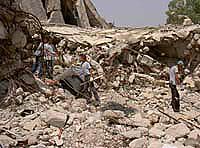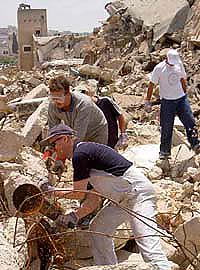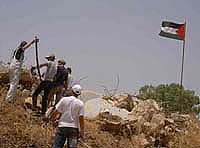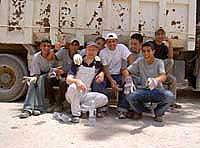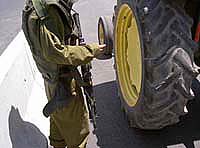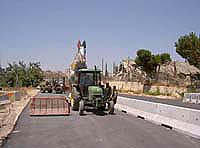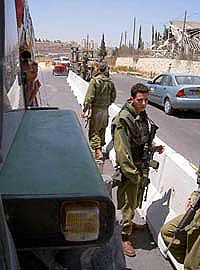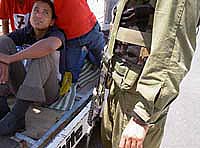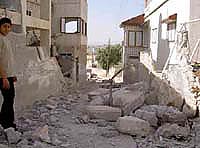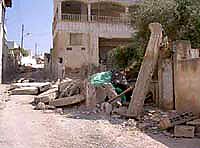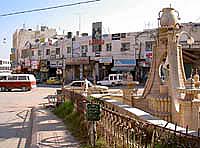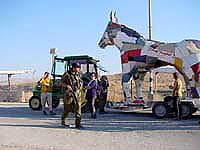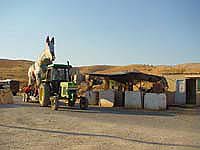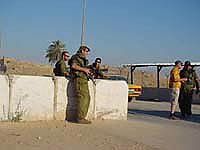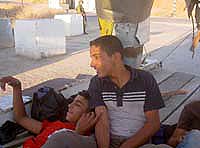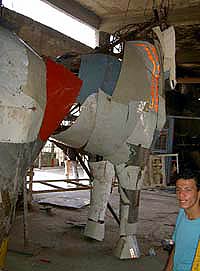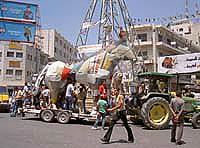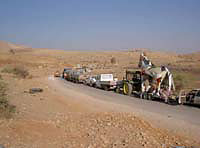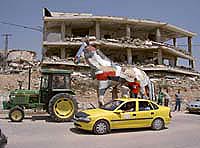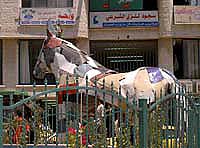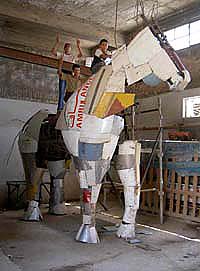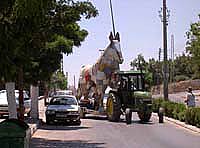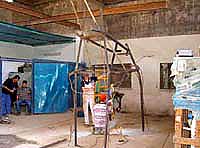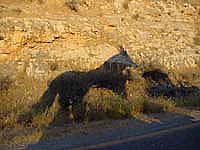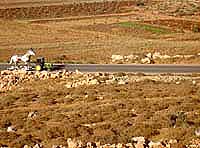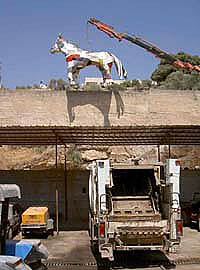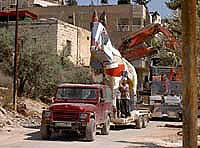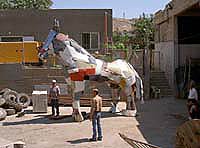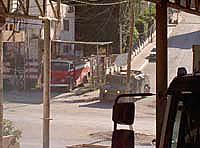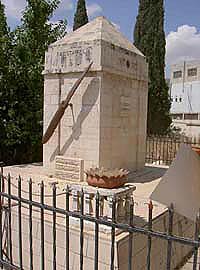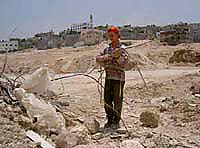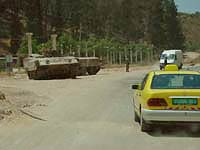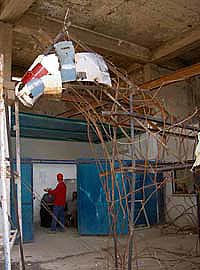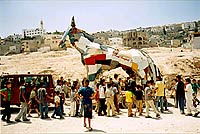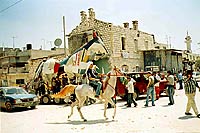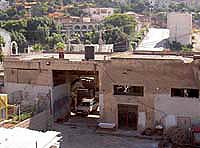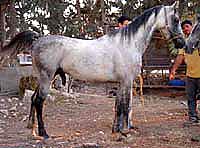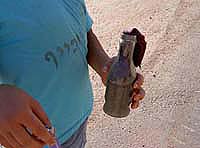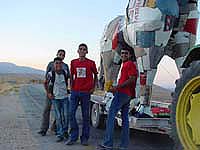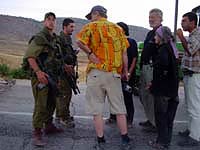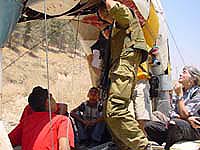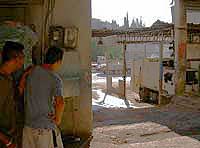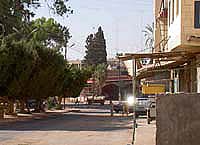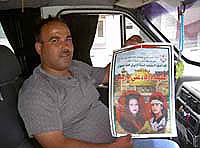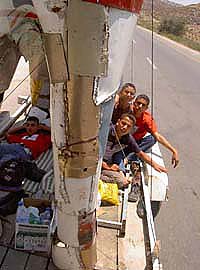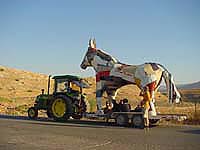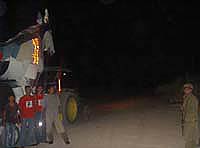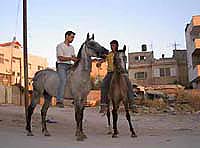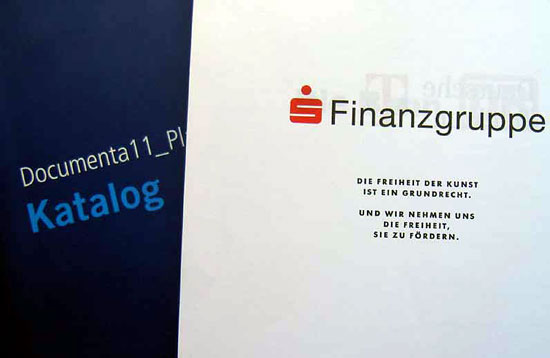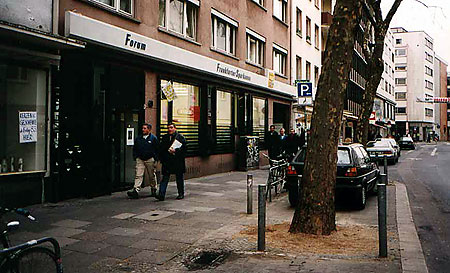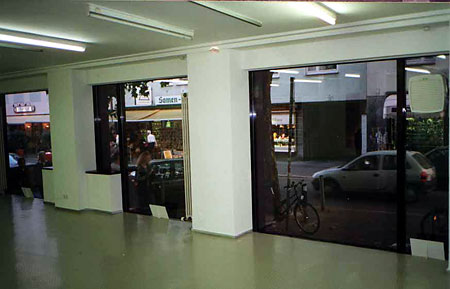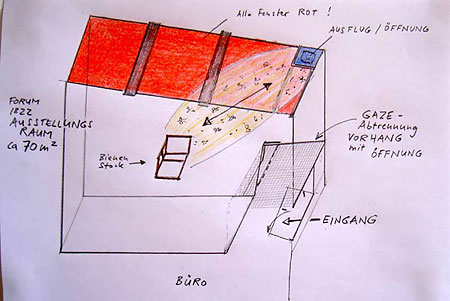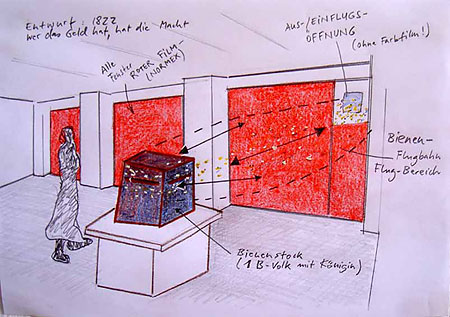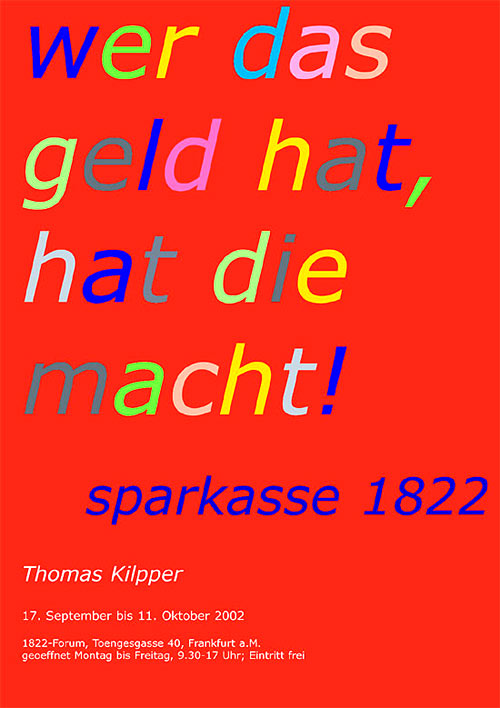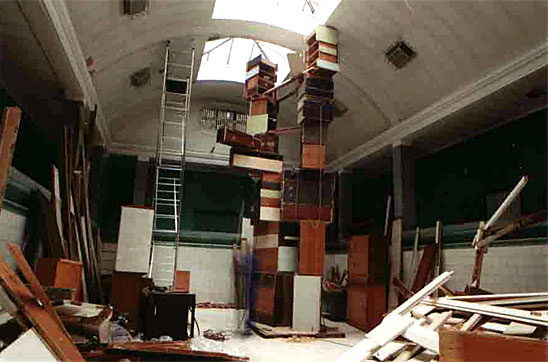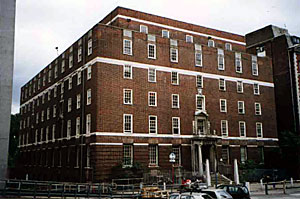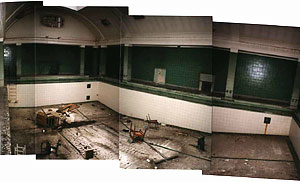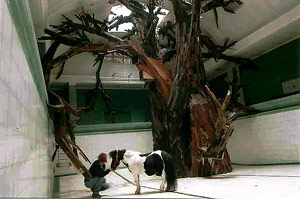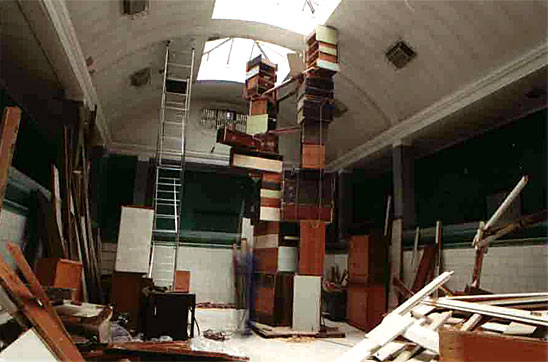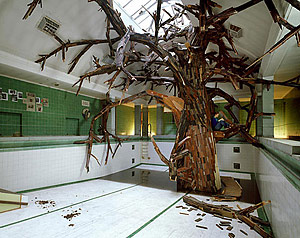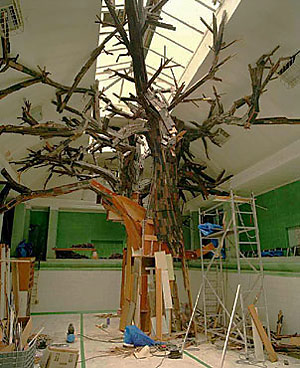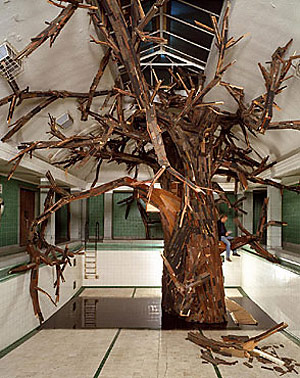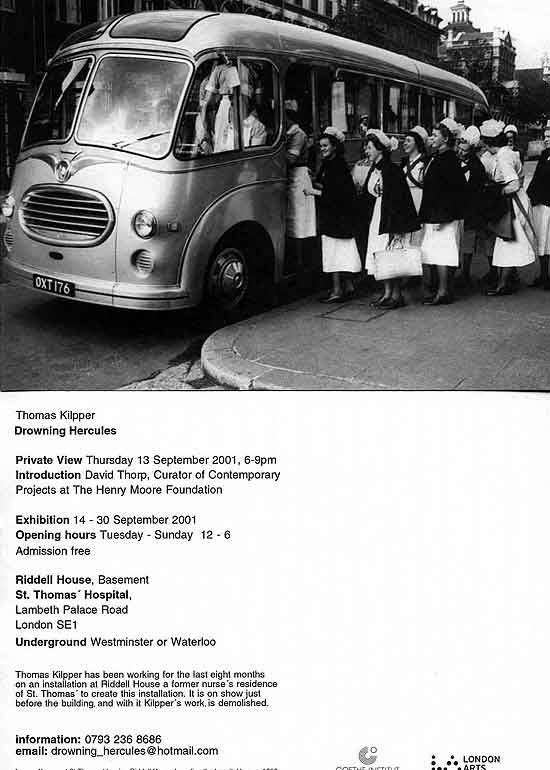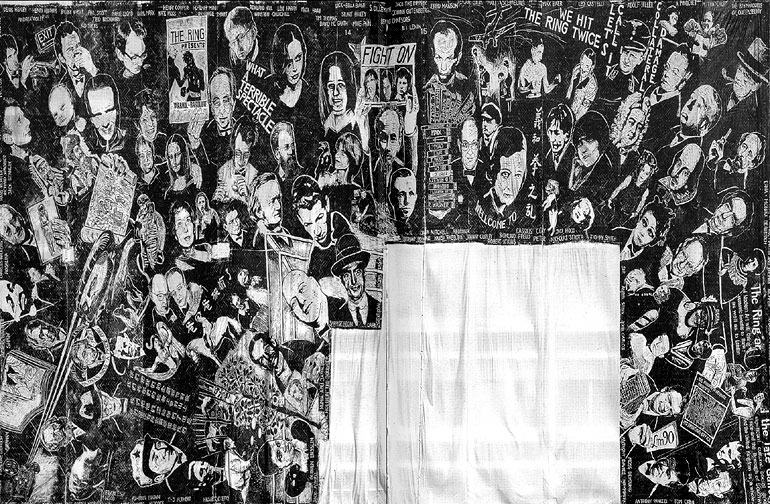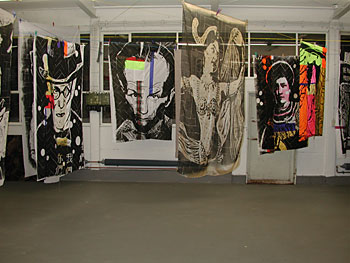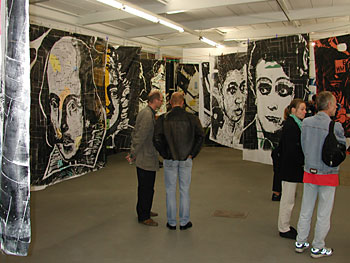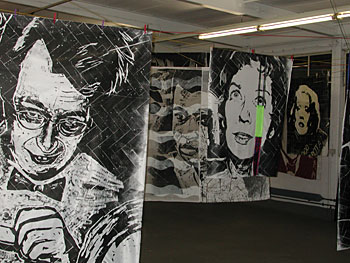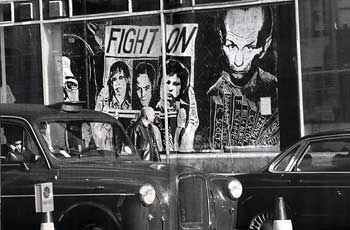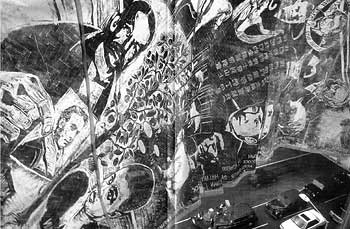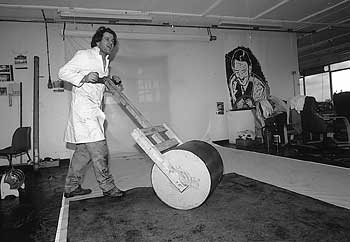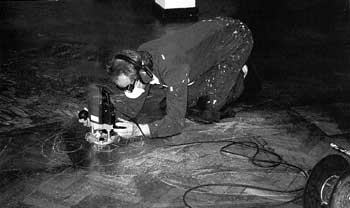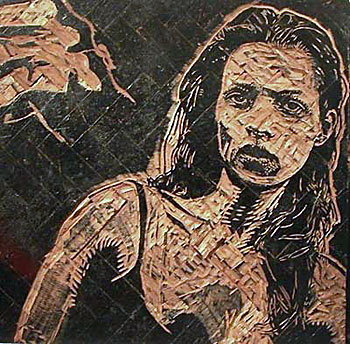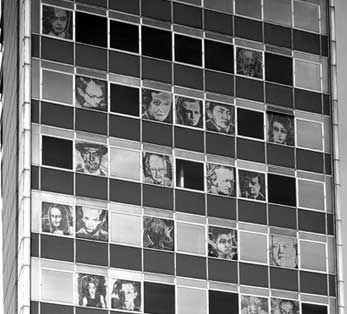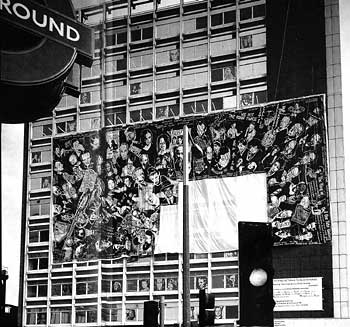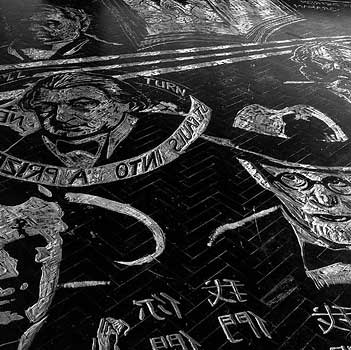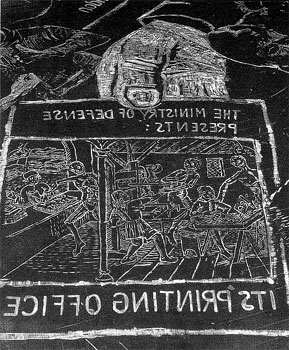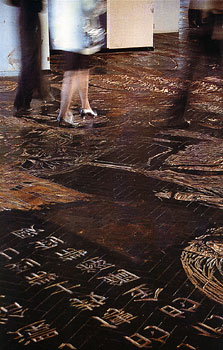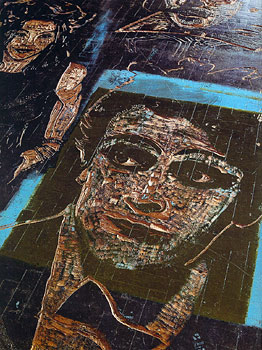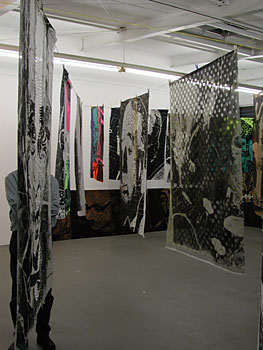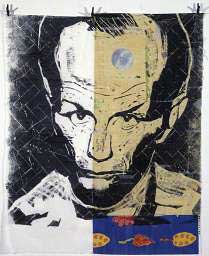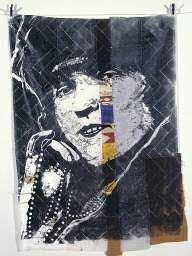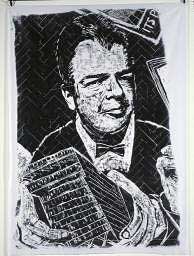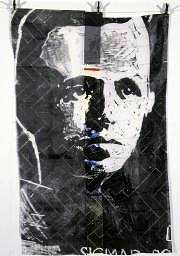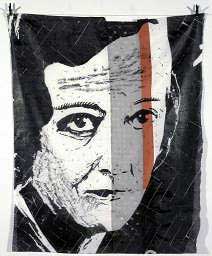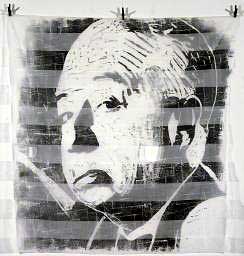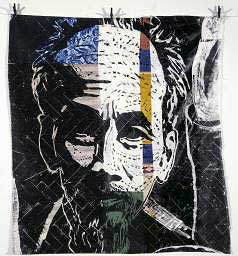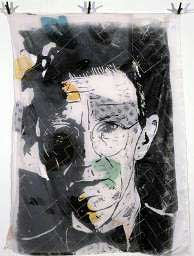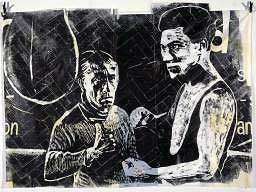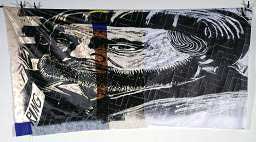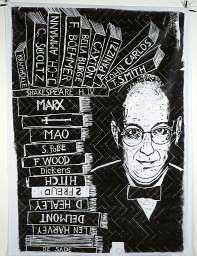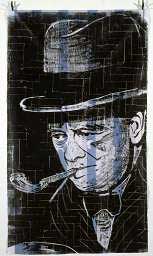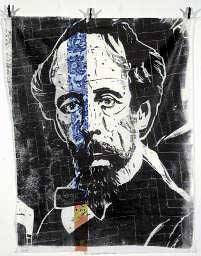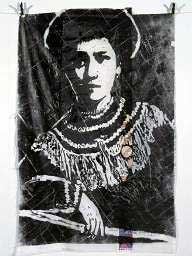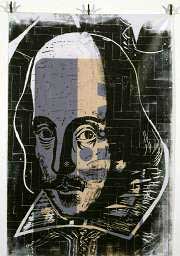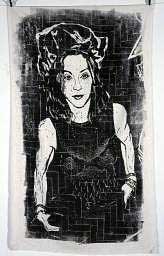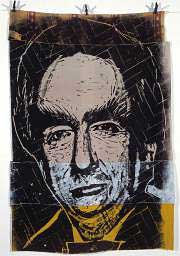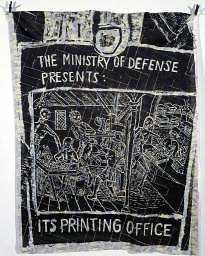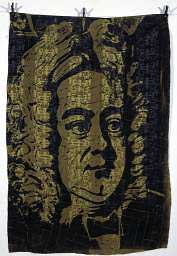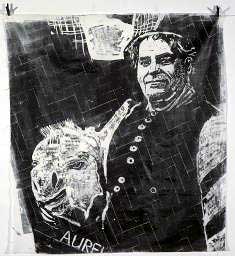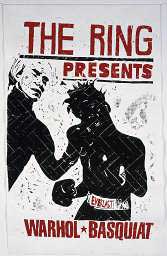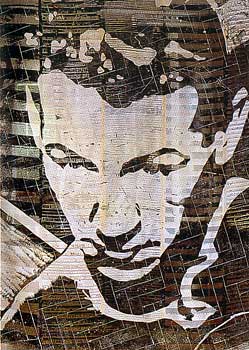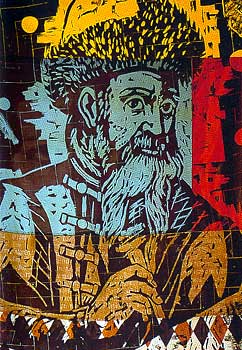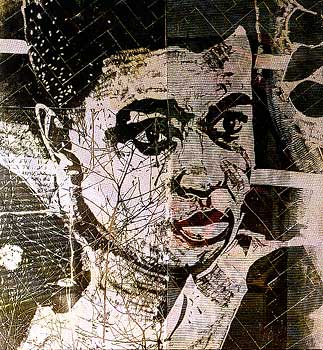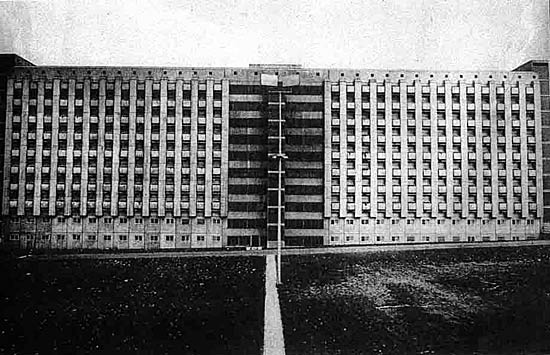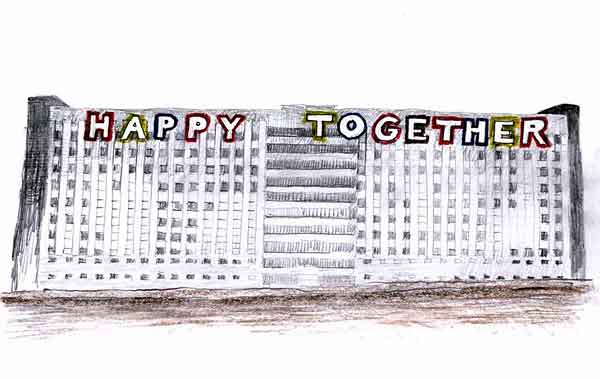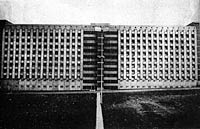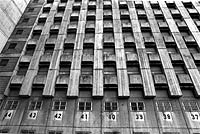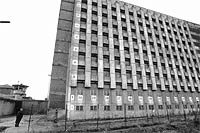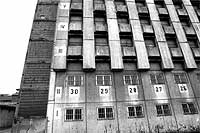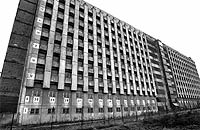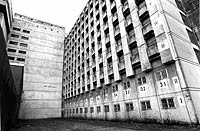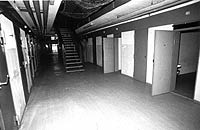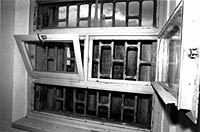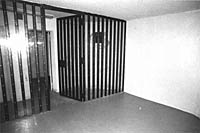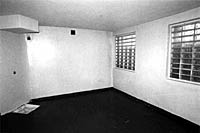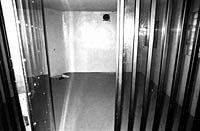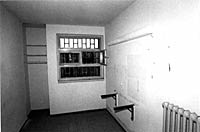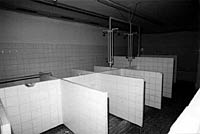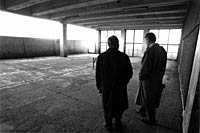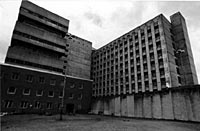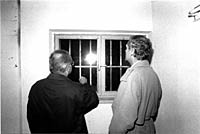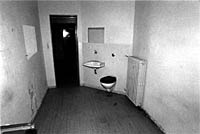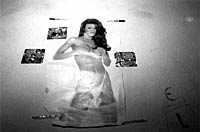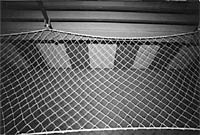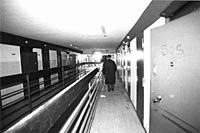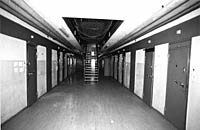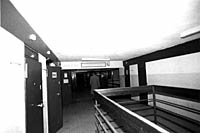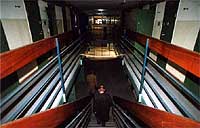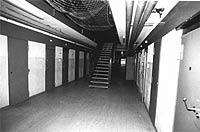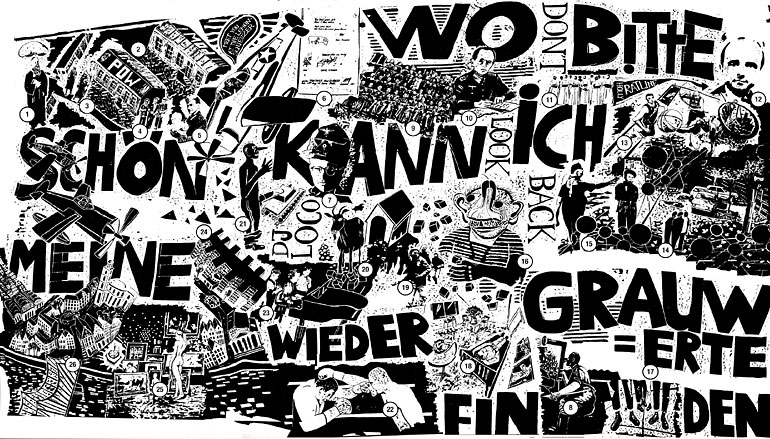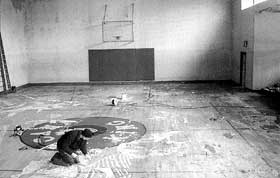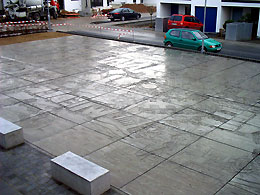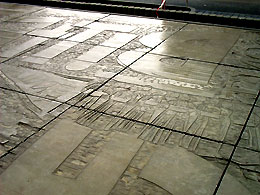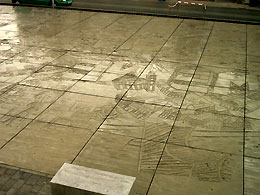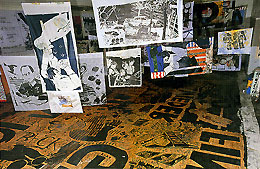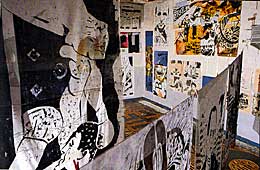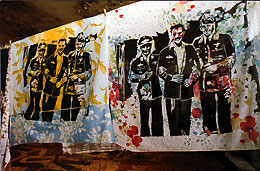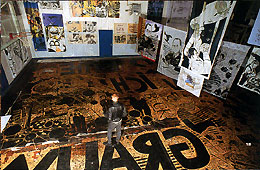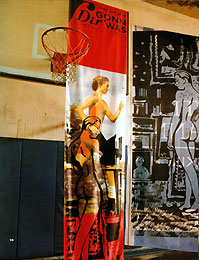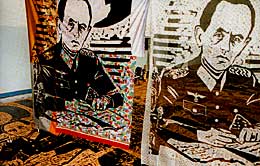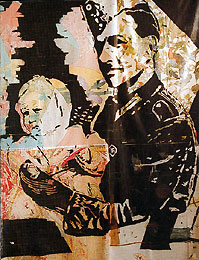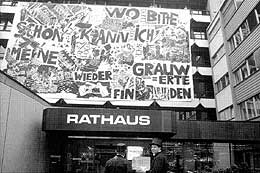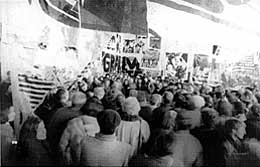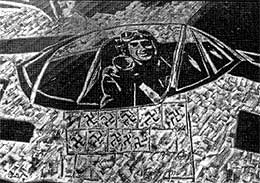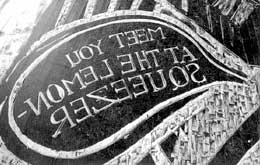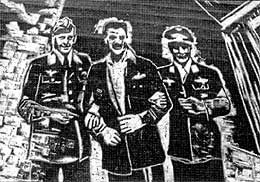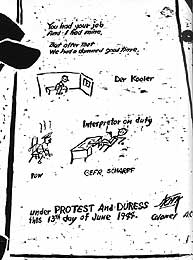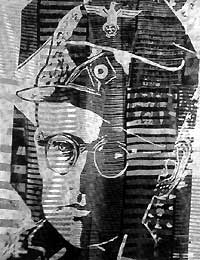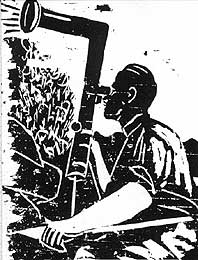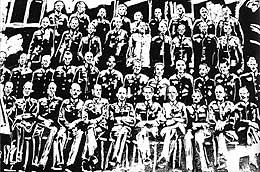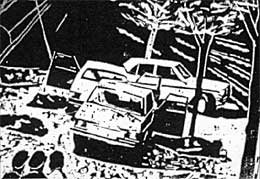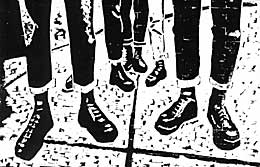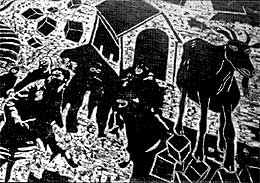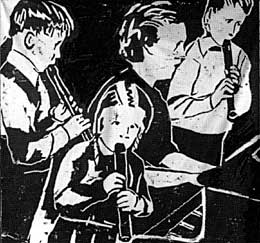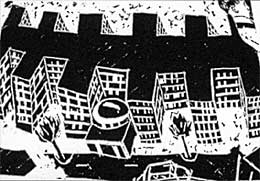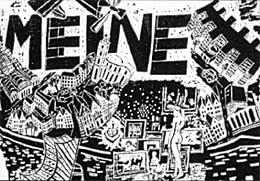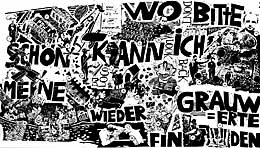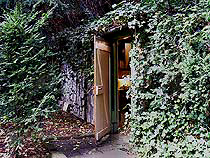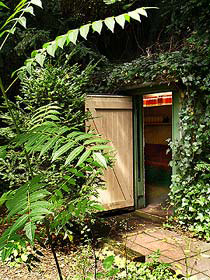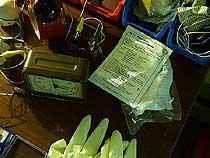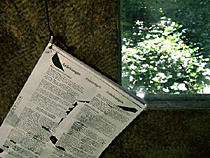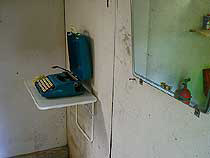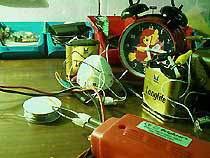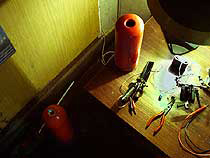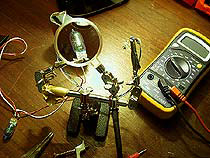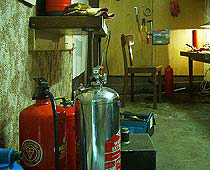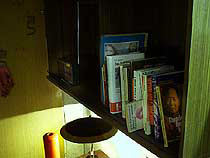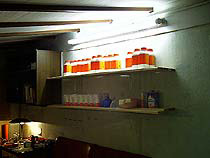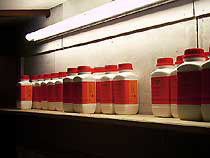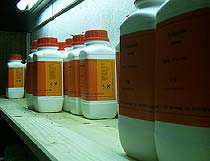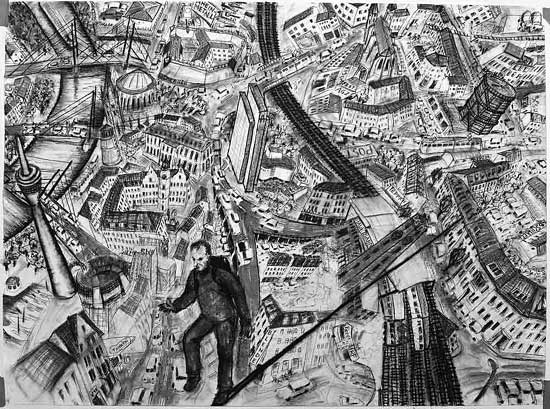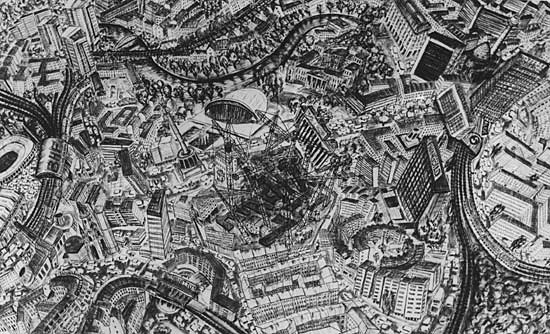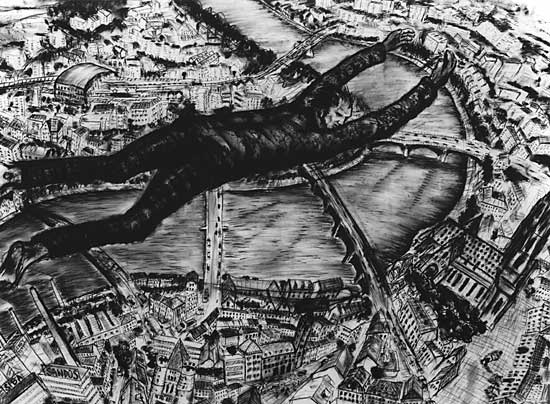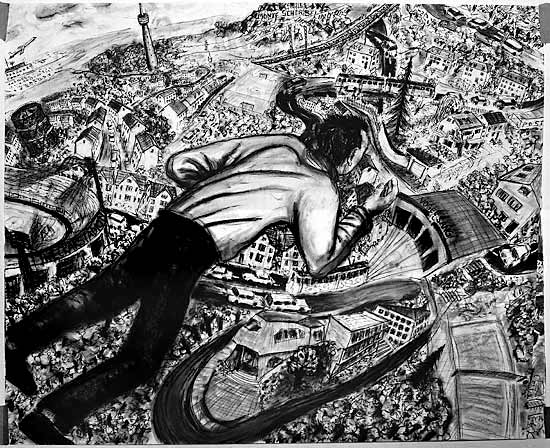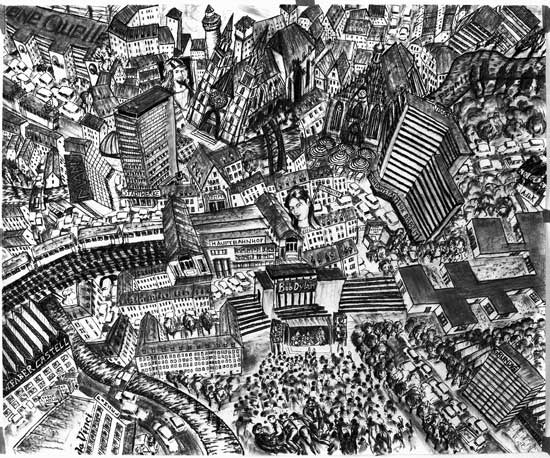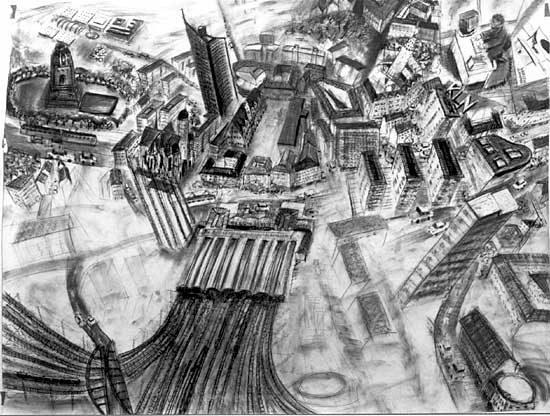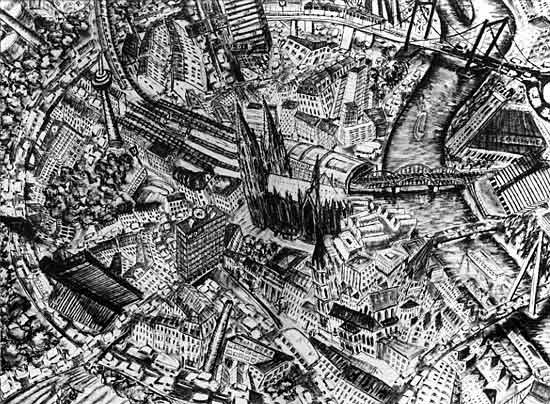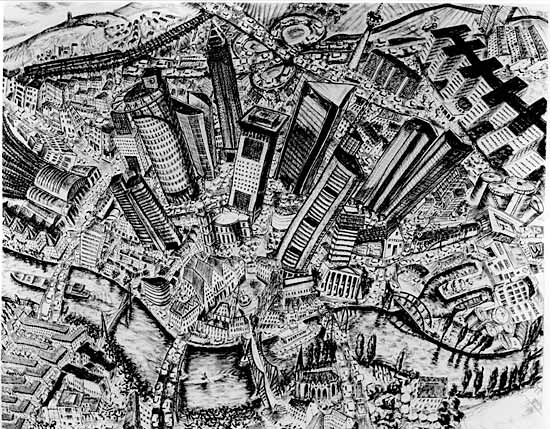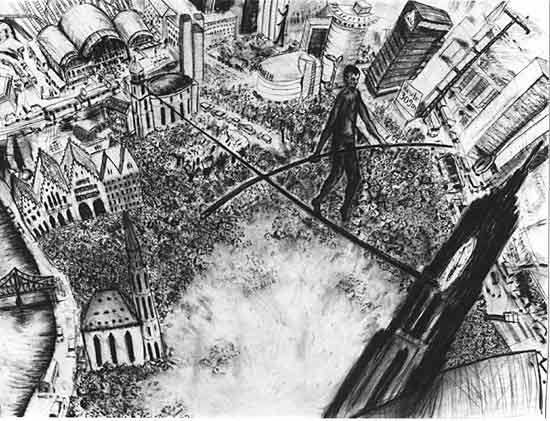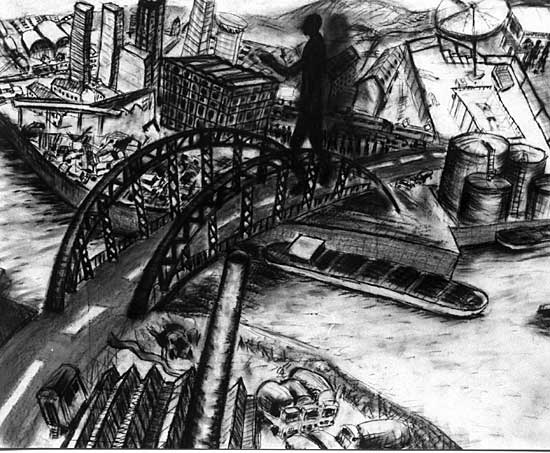info 15
dear all
on thursday 10th of july tom kay and I travel from ramallah to jenin to prepare our horse ride.
we arrive in jenin at about 1pm and go straight away to the town hall to talk to salahadin from jenin administration. over the last days salah arranged to get us a tractor for our trip (to pull the horse). he calls the owner of the tractor to meet with us in the evening. brilliant!
he phones ziad from the qattan foundation about the matter of insurance.
what if the tractor or the trailer or the horse gets damaged or destroyed etc… who covers any costs of fixing it? not an easy one this – may be we have to close our eyes about that and hope that we have just a bit of good luck.
tom and me go to the steed, examining what needs to be done before we can leave. the hoofs have to be closed again, screws tightened and a rope attached at the horse’s neck to fix it properly to the cart.
on the way to the town centre we pass my friend montaser’s workshop. he, his brother, father and some friends sitting infront of their blacksmith-workshop. we get a friendly ‘hello’ and invite for a drink but we explain we have to go to buy some bits and stuff. really helpful and unselfish he takes us in his little fiat to the shops. we buy screws, screw-driver, rope, gloves, pliers etc…
he then brings us to samer’s house in the refugee camp! what a nice chap, superb!
after a little siesta at samer’s place tom and I go for a stroll to ground zero and through the camp. I take some photos and do filming. suddenly we bump into zakariya the commander of the fatah al aqsa brigades in the northern westbank. this time no appache helicopter is in the air… and he is very relaxed. we sit down and begin to discuss. about the horse-project, their intervention, the proposed place to install it and a bit about the political situation and the difference between legitimate resistance and terrorism. interesting but difficult. unfortunately we don’t have a good translator who can speak arabic and english fluently.
in the evening we meet naser the owner of the tractor and arrange to meet for a “test-drive” the next day, friday afternoon. afterwards I take salah and tom out for a wonderful cocktail freshly mixed from several fruits at mahmouds bar. coming home to samer we
sit on the terrace enjoying a sweet watermelon (bati’ich) and smoking a lovely waterpipe (n’argila). as samer’s wife and children are at her parents house in a nearby village we, samer, tom and I go to bed all together in his living room. it reminds me of my early years in the eightees when we lived together commune-like with functional but private rooms.
friday we fix the horse and prepare it for the tours. in the afternoon naser comes with his tractor and I do a short test-drive. although I feel able to do the job naser is not happy about my driving abilities and clearly hesitates to give me his tractor. so I ask him what might be better for him. “would you prefer to drive it yourself? could you join us?” surprisingly naser agrees to do so. wow! that is even better for me and us – we not just have a tractor but a driver, too. and what a smart one. it is a real pleasure to look at him. deep furrows draw striking lines over his cheeks – sparkling but gentle eyes seem to reveal his cleverness. really love him.
in the late afternoon montaser takes tom and me to a local spectacle: horse racing. about 20 horses and riders meet on a field pritty close to the centre of jenin. some horses are amazingly fast leaving huge clouds of dust behind them with very talented riders: riding without a saddle! in the evening we get a delicious dinner with montaser’s familly on their terrace. his sister is a lovely cook. she works at the hospital as a nurse and speaks fluently english – unfortunately she didn’t join the dinner and stayed with the other female members of the familly in a seperate room.
we just finished the dinner when two of “my” youngsters who worked on the horse – kahled and rimah – turn up, “we want to come with you and the horse to ramallah…” – so far I informed as many participants as possible about my intentions. now it is the first time that two of them clearly express they are determined to join. my palestinian friends and tom kay, who lives in ramallah since 1 1/2 years are very much concerned about that development. “they will get sent back if not arrested…”. we slipped into an intense and partly controversial debate whether it is responsible to take the youngsters with us or not… and I clearly felt: I only can let them know what might happen and if they are still prepared to take the risk I can’t keep them out and say “no, you can’t join me you must stay in jenin…”. they helped me building the beast – so of course they may join it on a journey through their country. their country they almost can’t travel! and what happens if we get stopped or the kids sent back or arrested? my attitude is we have to be aware there might be danger and we have to sort out the concrete problems step by step once they occured.
next morning we finish preparations, collecting a big branch and a provisonal ladder to lift any potentially low hanging power cables or other obstacles across the streets… a municipality worker tells me I have to get a permission in writing to take the horse out “for my ride”… and I try to get samer, my assistant and welder freed from work and on board. so I spend quite a time in the offices of the townhall.
everything seems to be ready for take off… what about the youngsters? how did they decide? there come five of them, not only kahled and rimah but also rasim, ibrahim and hasan. all of them from the refugee camp. I call one of their daddy’s to get a feed back that this is ok with him. I hear in the worst quality of mobile-phone-reception you can imagine a chopped “yes, it is ok.” but I must send hasan back. I feel sorry, but he is younger than the others and joined the workshop (inofficially) half way because his brother kahled participated.
amira haas, a brave israeli journalist who lives within the palestinian territorries for the last 4 years, tom and his wife adah (from london), who live in ramallah and maeggi with her husband peter from the states came to join the bandwagon, too.
I look out for them to inform them that I want to start right now, but I stumble straight into a political discussion in a small office. here I get confronted with some palestinian statements praising germany and its governmental policy. I have to contradict and insist “I don’t feel german, I am just born in germany” – not only our past (two world-wars, the nazi-fascism, the holocaust…) but also the presence is politically devastating (closing the borders for refugees, racism, occupation forces in afghanistan, tanks in kuwait, soldiers on the balkans, may be soon in iraq, too etc…) anybody who thinks this is positive? nobody… nevertheless most of them still think I should feel positive about my country/nationality. but one representative from the refugee camp, jamal he understands and explains it to the others.
at long last we start at 11.30 am. we take nablus street to the south. soon,
after ten minutes the first checkpoint is to be seen. two massive tanks positioned in a 90 degree angle to eachother block the road. I collect all our passports and ID’s and present them to the soldier in charge. “what’s that?” “well, it is an art-project we carried out together over the last weeks… and we are going to put it on show in ramallah…” my letter from the goethe institute confirms that. he takes a look inside the horse’s belly not without a smile. his mood seems to be something between beeing amused and irritated. his colleague next to him approaches the youngsters on the trailer rather provocative: he gives rimah a ‘soft’ slap and asks him in arabic “how are you (ki fa’la)?”. rimah stays calm. he doesn’t take on the provo. the charme of the horse seems to work: after a short while we can pass. great! we are now in a very good mood!
we move quite slowly. the steed squeaks and groans because of the bumpy road strewn with hundreds of potholes. we pass some quarries with many stone hewers, fields with farmers to harvest the vegetables and fruits…, in quabatiya, the first town after jenin, we cross the new vegetable market and later we pass all these cafes with so many men sitting in front of them.
once the horse is discovered they all look happily surprised if not stunned but clearly amused. their twisting hand signals the simple question “what is this about?” and the youngsters shouted hundreds of times “we are from jenin-camp, we are going to ramallah…”
because of the traffic in the town we come to a standstill, what makes it even more exciting and the four rush into their slogans, tremendously quick.
this could be the new beat of arab rap-music. the horse breed – an arab thorough-breed with thick legs – is new, why not creating a new trend in arab music, too?
the project – the moving horse – now has pritty much the character of a little popular festival – so may be I achieved a work of real (palestinian) pop-art.
after qabatyia fields again, olive trees, rocky mountains and dust. the horse provides enough shadow and the deserted country-side the adequate quietness for us to have a little breather. but only twenty minutes. and we arrive again a polulated area. the first houses of zebab’da and if I get it right we are forced to stop by an electrical line across the road right in the centre next to the place where all the yellow cabies are waiting for their passengers… one of the most vibrant and colourful places in palestinian towns. kahled gets the big branch, ibrahim climbs on the tractor and lifts with kahleds help the cable. naser moves carefully and slowly until the ears have passed. the excitment with joyful cheering, some political slogans, reachs a new peak. arab carnival. wounderful. as if the actual topograghy of this area is made for us. vibrant towns and deserted fields take turns with a perfect wave-like rhythm. so we don’t get exhausted too quick…
following this rhythm we have once more the ‘calmness’ of the country-side (apparently calm as the next tank or sniper can be around the corner, behind the trees or on the next hill-top), large fields mainly with olive-trees.
burning heat. the street is glimmering.
next little town is aqqaba. we pass a completely destroyed large building right in the centre of the town, I guess it was the local building of the palestinian authority. perfectly flattened. blowing up – a job the israeli army certainly masters. nonetheless again a noisy welcome, cheering and waving our hands to the local people in the street and vice versa theirs to us.
fields again, trees – some lovely, colourful birds I have never seen…
before we are descending the hill we have a great view into the plain area with the beautiful town of tubas. I get down from the bandwagon to take some video shots with the horse moving smoothly through the fields and approaching the town. to catch up again with the others I try to get a lift – and even he is (downhill) pritty fast one driver stops to pick me up. “do you know a good place in tubas to get a shawarma-sandwich…”. “no problem, I’ll take you there”. we pass the trek and tell them to join his car for our lunch. tubas main street, about 2pm: 13 sandwichs are to be ordered and freshly prepared. everybody is more than hungry and happy about the break.
we know the next checkpoint is soon due to come. it will be a crucial – may be the most difficult one and we have to be fit.
an hour later we start again. soon we are in the middle of vast fields, but now the landscape narrows, after passing the small town al far’a camp we are heading down a little valley, palm trees, water at the bottom – the four almost get flipped out about the water. here where it would be going to be really romantic we have to pass a smelly, smoky waste-land right above the brook… no other place to throw the rubbish?
the valley gradually widens, here we pass more and more bedouin tents, shepherds guarding their flocks, mainly sheep and goats, few cows. only alongside the river green banks and fields are drawing a relatively thin line of prosper agriculture. the vast majority of the land looks pritty dry.
the wind towards us, coming up the valley turns hotter and hotter – almost desert-like. we are just 10 km away from the jordan valley, the lowest area on earth. about 200 meter below sea-level. as if you can feel the glowing of the earth’s core.
hamra checkpoint. we arrive at about 4pm. already some twenty cars waiting in a queue. we estimate half an hour to wait before we get checked. but just five cars get controled, two of them get turned away. loaded with newly manufactured furnitures, (which are only partly covered with plastic sheets, torn up to loose pieces due to heavy air stream…) they are ordered to go back! must be a pain in the arse. and not a good sign for ourselves either.
if the soldiers are not relaxed (‘generous’?) with others why should they be so with us…? and then nothing goes. no car can pass at all for more than one hour. peter – how great, he manages to bring an entire box of apples. refreshing and delicious luxury! everybody grabs at least one if not more.
at 5pm new soldiers arrive. seems to be a change of shift. but they wait until 6.20 when they start further security checks.
2 1/2 hours after the arrival at hamra it’s our turn. the horse moves between the concrete roadblocks and the muzzles of about half a dozen uzi’s and other automatic weapons. the soldier’s faces tell again some positive feelings. surprise and amusement. the force of the horse’s charme. I pass on our ID’s to the soldiers.
in a parallel control an officer of the israeli police (they appeared half an hour ago at the checkpoint with their blue landrover) checks the details of naser, the tractor driver. driving license, tractor insurance etc… after five minutes he seems to be satisfied. naser gets back his certificates, no objections from police’s side to proceed.
but the commanding soldier stays firm, he says he requires a special permit from the CLO (the army’s coordination and liaison office). “if you haven’t got that permit to pass, we can’t let you go. why haven’t you got a permission from the CLO?” I don’t want to tell him, that this was part of my decission, not to apply and not to show too much acceptance of their authority in advance. (the westbank is simply not their land. they are occupying other peoples country…) instead I let him know “it was a relatively spontaneous decission to do the journey, we had not the time to apply…” – so he urges me to call the CLO in jericho.
I dial the number I am given and explain the case to the officer but somehow we get stuck with our communication. the commanding soldier of the checkpoint now takes my mobile phone and explains the situation again, now in hebrew. amira stands next to me, following and translating his conversation. it appears to happen a miracle, the CLO-officer tells his colleague he just issued a permission for our treck to pass!
wow! we get the okay to move on! how come? still excited I call farid, the director of the goethe institute in ramallah. this is rather unexpected.
I learn from farid, that he has sent a fax to the army (CLO?) to inform them about this trek and art-project. did I know about it? can’t remember.
anyway, farid means it would be the first time this would have any impact.
so it is something in between – not a proper application and not a proper lack of cooperation but an information so they may still feel respected enough…
after hamra the streets are going to be at least two classes better, here many israeli cars are underway – foremost settlers. if they get aware of the horse their reaction is so different from the palestinians. not one smile. just motionless severe and cold looking. why this? don’t know.
7pm – we have now a very nice warm light – the sun sinks more and more down and this brings us a nice fellower, everytime we pass one of the embankments or a little hill a second horse appears to be with us. looks great even it is just for some seconds.
between gittit and ma’aleh efrayim settlement comes another checkpoint, just 10 km after hamra. the commander seems to be very young, he – in contrast to his colleagues – has a fairly nasty approach. (we could see that he checked the lorry in front of us up and down and again and again – which didn’t make any sense but to provoke problems. at least we had to wait for more than half an hour…) but with amira’s help talking in hebrew to him he can get persuaded to call the CLO and receive authorization to let us pass. once more.
after this roadblock we gradually climb the mountain and the air is getting fresh. from about zero up to 800-900 metres above sea-level. I have just a blanket (give it to rasim) and my jacket which I pass on to ibrahim who widely loses himself in it. but it looks good, really cute.
the last hurdle (or is it a corral for our horse) to be taken seems now the time, as qalandia, the “normal” checkpoint to enter ramallah closes at 9 pm.
imagine! nine o’clock last entrance into your town! even in the middle ages towns were longer open!
naser shows his tractor the whip, we almost fly up the hills. but we clearly can not match this time-table – at 9.30 we have still some 10 kilometres to go. we are definitely too late for qalandia.
there is only one chance: to call farid from the goethe and get through the diplomats and VIP checkpoint of bet el with his help. I call him and he happily agrees to come and help.
we arrive just in time before this checkpoint closes (at 10pm), too. no lights, pitchdark, rather ghostly this roadblock… a soldier sends us a flashlight-signal to approach the actual control. farid did already speak to the officers, so it goes smoothly. they check us and the horse (inside and outside) but passing the diplomats entrance without problems means we and our horse are treated statesmanlike…
shortly after 10pm we enter ramallah and once again an enthusiastic partly effervescent “hi and hello” is echoeing in the streets. proudly as if a dream comes true the four let everybody know “we are coming from jenin, from the jenin camp!” we circle twice the round shaped central square of al manara, the horns sound and get mixed with clapping, cheering and shouting with cracking voices…
we park the bandwagon at the municipality workshop 10 minutes away from the centre and meet at tom and adah kay’s house. we try to plan the next day, but soon feel too tired – dead tired in fact. at midnight rimah, ibrahim and I arrive at my flat. we prepare our beds, I take a shower – coming out of the bath the kids are gone, my door stands wide open… I call them, the only response I get is the hiss of a nearby cat.
soon more to come
best
thomas
ps: the link to amira haas’s article in the israeli newspaper ha’aretz is:
[link]

